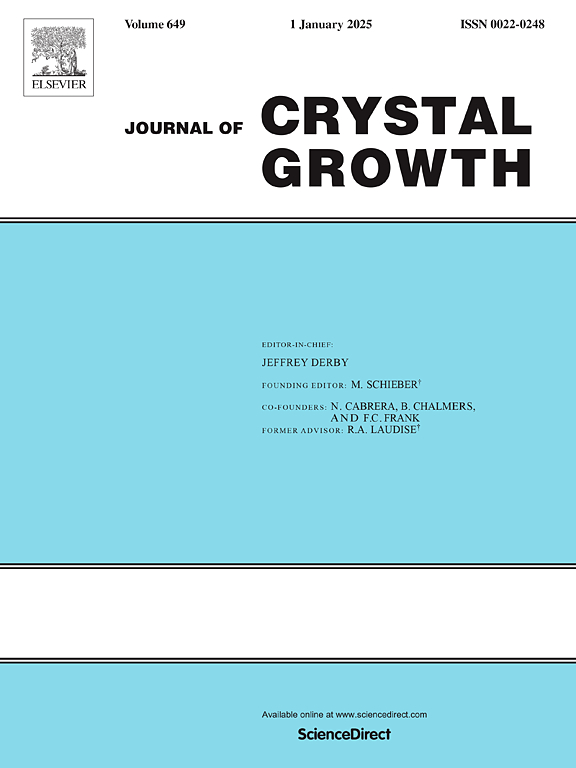The critical role of hydrocarbon source and growth optimization for high-quality thick 4H-SiC epitaxial layers
IF 2
4区 材料科学
Q3 CRYSTALLOGRAPHY
引用次数: 0
Abstract
The development of ultra-high power electronic devices based on 4H-SiC relies on the growth of high-quality thick epitaxial layers. Chloride-based chemical vapor deposition is preferred for this purpose, and in this study we show that optimizing the process also requires a careful selection of hydrocarbons as the carbon source. Propane, a common precursor, limits control over the C/Si ratio at high growth rates, leading to defects and even loss of crystallinity. In contrast, methane offers a wider window for C/Si ratio adjustment, enabling further optimization of the epitaxial growth process. Using methane, an optimal growth rate of /h is identified at which the minority carrier lifetime is maximized. Additionally, a saturation limit for minority carrier lifetime is observed in layers exceeding a thickness of . It is also shown that, although the formation of characteristic surface morphological defects is inevitable, their severity can be controlled by adding additional HCl or increasing the growth rate; however, at a cost of reduced minority carrier lifetime. The growth of thick epitaxial wafers with methane and propane demonstrates the advantage of using methane as the carbon source. This is evidenced by a smoother surface, better doping uniformity, and nearly double the minority carrier lifetime compared to the propane-grown wafer. These findings highlight the benefits of methane in growing thick 4H-SiC epitaxial layers for high-power devices.
碳氢化合物来源和生长优化对高质量厚4H-SiC外延层的关键作用
基于4H-SiC的超高功率电子器件的发展依赖于高质量厚外延层的生长。基于氯化物的化学气相沉积是用于此目的的首选方法,在本研究中,我们表明优化该工艺还需要仔细选择碳氢化合物作为碳源。丙烷是一种常见的前驱体,在高生长速率下限制了对C/Si比的控制,导致缺陷甚至结晶度的丧失。相比之下,甲烷提供了一个更宽的窗口来调整C/Si比,从而进一步优化外延生长过程。利用甲烷,确定了25μm/h的最佳生长速率,使少数载流子寿命最大化。此外,在厚度超过~ 100μm的层中观察到少数载流子寿命的饱和极限。结果还表明,虽然表面形态缺陷的形成是不可避免的,但可以通过添加额外的HCl或提高生长速度来控制其严重程度;然而,这是以减少少数载流子寿命为代价的。以甲烷和丙烷为碳源,生长出了125μm厚的外延片,证明了甲烷作为碳源的优势。与丙烷生长晶圆相比,表面更光滑,掺杂均匀性更好,少数载流子寿命几乎翻了一番。这些发现强调了甲烷在高功率器件中生长厚的4H-SiC外延层的好处。
本文章由计算机程序翻译,如有差异,请以英文原文为准。
求助全文
约1分钟内获得全文
求助全文
来源期刊

Journal of Crystal Growth
化学-晶体学
CiteScore
3.60
自引率
11.10%
发文量
373
审稿时长
65 days
期刊介绍:
The journal offers a common reference and publication source for workers engaged in research on the experimental and theoretical aspects of crystal growth and its applications, e.g. in devices. Experimental and theoretical contributions are published in the following fields: theory of nucleation and growth, molecular kinetics and transport phenomena, crystallization in viscous media such as polymers and glasses; crystal growth of metals, minerals, semiconductors, superconductors, magnetics, inorganic, organic and biological substances in bulk or as thin films; molecular beam epitaxy, chemical vapor deposition, growth of III-V and II-VI and other semiconductors; characterization of single crystals by physical and chemical methods; apparatus, instrumentation and techniques for crystal growth, and purification methods; multilayer heterostructures and their characterisation with an emphasis on crystal growth and epitaxial aspects of electronic materials. A special feature of the journal is the periodic inclusion of proceedings of symposia and conferences on relevant aspects of crystal growth.
 求助内容:
求助内容: 应助结果提醒方式:
应助结果提醒方式:


